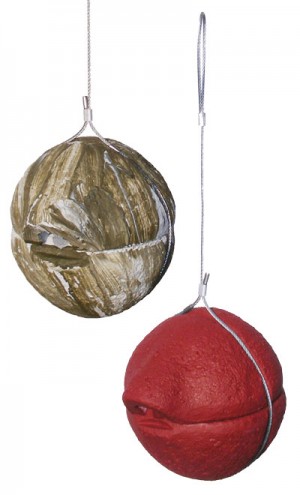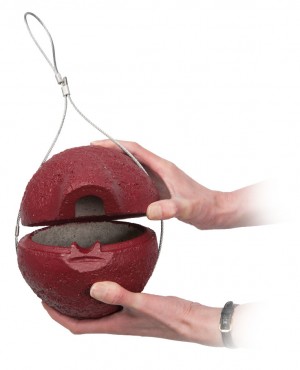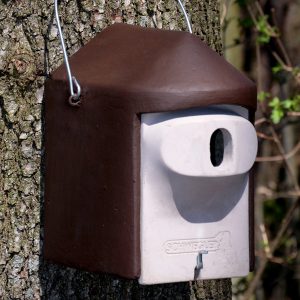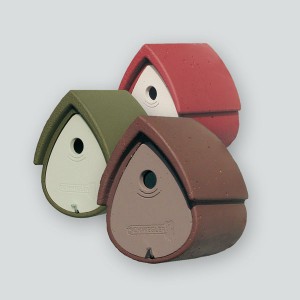The Wren is a familiar sight. This plain little fellow is instantly recognisable from his loud, warbling call which is delivered from an exposed position, although the young are hidden out of sight in (semi-)shadow, in hedges or behind a screen of ivy. The male Wren usually builds several nests. The female then chooses the one she considers the best and lays between five and eight tiny eggs. In view of this characteristic breeding behaviour it is advisable to hang up several 1ZA Boxes.
Spherical Wren House 1ZA
Registered design
Distribution: Wrens are found virtually all over the world, being indigenous to Europe, North America, Asia and North Africa. It is a so-called sedentary species, spending the winter among us. However, part of the population is known to migrate.
Feeding habits: Wrens feed exclusively on small creatures. Their favourite food is spiders, crane flies, moths, flies and other insects, along with their eggs and larvae. They use their pointed beak to probe cracks and crevices. Consequently Wrens are very useful as a form of natural pest control.
This special nesting aid: The spherical SCHWEGLER 1ZA Wren House is an ideal way of assisting the Birds to raise their young successfully. Because we tend to keep our gardens tidy, they offer fewer natural nesting opportunities. Extensive investigations have shown that Wrens prefer an enclosed, round nest hole. These are then lined with moss, feathers and fur, etc. The 1ZA, made of tried and tested SCHWEGLER wood-concrete, provides excellent protection from nest predators. It not only houses Wrens when bringing up their young but also provides a place where they can sleep in the winter.
Materials used: SCHWEGLER wood-concrete is a unique weather-resistant, long-lasting material which is also “breathable”, which means it prevents condensation. It is hung up using the integrated wire rope made of stainless steel which can be easily looped over a sawn-off branch, for example.
Siting: Wrens like to nest near the ground, in a ‘green wilderness’ and in undergrowth. They are not particularly good flyers, preferring to hop about in the undergrowth. They like shady places – in hedges, thickets, heavily overgrown areas and bushes as well as balconies.
Attachment: Hang the nest box in undergrowth, in a shady place. It can also be placed upon a pile of brushwood or garden clippings, for example. If hung in a totally unobstructed place it will also attract other types of Birds that nest in holes and cavities, including Blue Tits, Coal Tits and Great Tits, as well as Tree and House Sparrows.
Cleaning and checking: We recommend that you do not carry out any checks between April and June in order to avoid disturbing the brood. The nest box, which comprises two shells, should therefore ideally be cleaned during the autumn or winter months. To do this, remove the cable from which it is suspended. The upper shell can be easily lifted off the lower one. When cleaning has been completed simply place the two halves together again and secure using the cable.
Includes: Spherical Wren House with wire rope.
Dimensions: diameter of sphere approx. 18.5 cm.
Entrance hole: 30 x 27 mm.
Cable length: approx. 20 cm.
Weight: approx. 2 kg.
Available in individual gift package (carton).
Available in two colours:
With its speckled green exterior the “Ivy” colour blends well with the surrounding undergrowth, thereby providing a well-hidden nest site.
Ivy – green
Order No. 00 200/6
The “Autumn Light” natural red colour visually enhances your garden in the winter months. Once the leaves have fallen from the bushes this invaluable nesting aid becomes clearly visible and forms a focal point during the cold, grey months of the year.
Autumn Light – red
Order No. 00 201/3
 English
English Deutsch
Deutsch 








